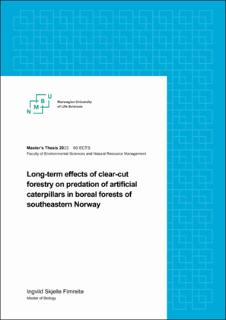| dc.description.abstract | Predator-prey interactions are one of the key ecological interactions contributing to ecosystem structure and stability within complex forest ecosystems. Intact forest ecosystems contain high abundances and diversity of prey and natural enemies, but impact from forest management intensities could potentially threaten these interactions. I used 640 artificial caterpillars made from brown or green plasticine to compare predation rates between 10 pairs of boreal near-natural (NN) forests and former clear-cut (CC) forests in the southeastern parts of Norway. Half of them were placed on tree stems, and the other half on bilberry bushes. Artificial caterpillars were placed out in two periods, from late May to late June 2022. Predation was measured in two ways: by recording the presence or absence of attack marks on caterpillars, which could indicate predation rates by arthropods, mammals, or birds; and by counting the number of arthropod attack marks per caterpillar. I also assessed the abundance of predatory beetles in traps and the occurrence of anthills in late June.
108 caterpillars were fully removed by unknown predators. From the remaining caterpillars, were 88% attacked by arthropods, 46% by mammals, and 14% by birds. Almost twice as many caterpillars were removed from the former clear-cut forests as near-natural forests (21% vs. 13%), especially on bilberry bushes, and during the second period. Forest type was a significant predictor of both presence of arthropod predation, and number of arthropod attack marks per caterpillar. The arthropod predation rates of caterpillars were highest in the near-natural forests, especially the first period, but caterpillars in clear-cut forests suffered more attack marks per caterpillar, specifically brown ones. Arthropod predators significantly preferred caterpillars on tree stems, particularly the first period. The colour preference of arthropods was only pronounced the second period, with significantly less predated green caterpillars. Both anthills and predatory beetles significantly increased arthropod attack marks per caterpillar. Bird and mammal predation did not differ significantly between the two forest types, they only showed a preference for caterpillars placed on bilberry bushes. My results indicate that different predators react differently to forest management regimes, caterpillar colour, and placement, highlighting the importance of further investigations towards impacts from forest type and other potential ecological interactions on predation rates. | |
